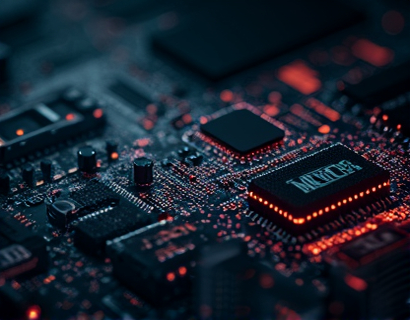Advanced Layer 2 Solutions: Transforming Blockchain Scalability and Developer Efficiency for EVM-Enabled Applications
In the rapidly evolving landscape of blockchain technology, Layer 2 solutions have emerged as a pivotal advancement, particularly for Ethereum Virtual Machine (EVM)-enabled applications. These solutions are designed to enhance scalability, security, and efficiency, addressing some of the most pressing challenges faced by developers and users alike. This article delves into the intricacies of advanced Layer 2 solutions, exploring how they transform EVM-based blockchain development and unlock the potential for the next generation of decentralized applications.
Understanding Layer 2 Solutions
Layer 2 solutions refer to protocols and technologies built on top of existing blockchain networks, or Layer 1, to improve transaction throughput and reduce costs. Unlike Layer 1 upgrades, which involve modifying the core blockchain protocol, Layer 2 solutions operate within the existing framework, leveraging it to achieve greater efficiency. For EVM-enabled applications, these solutions are particularly significant as they enable more complex smart contracts and decentralized applications (dApps) to function smoothly without compromising on security or decentralization.
Key Benefits of Advanced Layer 2 Solutions
One of the primary advantages of advanced Layer 2 solutions is their ability to significantly enhance scalability. By offloading a substantial portion of the transaction processing from the main blockchain to a secondary layer, these solutions can handle thousands of transactions per second, compared to the relatively limited throughput of Layer 1 blockchains. This scalability is crucial for EVM-based applications, which often require high transaction volumes, especially in use cases like decentralized finance (DeFi), gaming, and supply chain management.
Security is another critical aspect where advanced Layer 2 solutions excel. While some early Layer 2 protocols raised concerns about centralization and potential vulnerabilities, modern solutions have addressed these issues through innovative designs. Techniques such as state channels, sidechains, and rollups ensure that transactions remain secure and verifiable on the main blockchain, maintaining the integrity of the system. This balance between scalability and security is essential for building trust and adoption among developers and end-users.
Efficiency is a third pillar of advanced Layer 2 solutions. By reducing the computational and storage requirements on the main blockchain, these solutions lower transaction fees and decrease confirmation times. For developers, this means faster development cycles and lower operational costs, enabling them to focus more on innovation rather than scalability bottlenecks. The enhanced efficiency also translates to a better user experience, with quicker transaction settlements and smoother application performance.
Types of Advanced Layer 2 Solutions
Several advanced Layer 2 solutions have gained prominence in the blockchain ecosystem, each with its unique approach to addressing scalability and efficiency. Some of the most notable include Optimistic Rollups, ZK Rollups, and State Channels.
Optimistic Rollups bundle multiple transactions into a single transaction on the main blockchain, assuming they are valid. If any transaction is found to be invalid, the system can challenge and revert the batch. This approach significantly reduces gas fees and increases transaction speed, making it ideal for high-volume applications. However, the assumption mechanism requires a grace period for challenges, which can introduce slight delays.
ZK Rollups, on the other hand, use zero-knowledge proofs to bundle transactions and provide a succinct proof of validity. This method offers even higher throughput and faster confirmation times compared to Optimistic Rollups, as it does not require a challenge period. The trade-off is a higher computational overhead for generating the proofs, though this is generally offset by the increased efficiency gains.
State Channels allow for off-chain transactions between two or more parties, with the final state being submitted to the main blockchain once the channel is closed. This solution is particularly effective for applications with frequent, small transactions, such as gaming or micropayments. State Channels minimize the load on the main chain, resulting in lower fees and faster transaction times.
Enhancing Developer Efficiency
For developers, advanced Layer 2 solutions bring a host of benefits that streamline the development process and enhance overall efficiency. One of the most significant advantages is the reduction in gas costs. With Layer 2 solutions, developers can execute complex smart contracts and handle high transaction volumes at a fraction of the cost associated with Layer 1 blockchains. This cost efficiency allows for more ambitious projects and features without the financial constraints that often limit development.
Another key benefit is the improved development experience. Layer 2 solutions often come with robust development tools and libraries that simplify the process of building and deploying dApps. These tools abstract away many of the complexities associated with interacting directly with the main blockchain, enabling developers to focus on core functionality and user experience. Additionally, the faster transaction confirmation times and higher throughput provided by Layer 2 solutions enable quicker iteration and testing, accelerating the development cycle.
Security is also a major concern for developers, and advanced Layer 2 solutions address this by maintaining the immutability and verifiability of transactions on the main blockchain. Developers can trust that their smart contracts and dApps are secure, knowing that any discrepancies will be detected and resolved through the Layer 2 mechanism. This trust is crucial for building reliable and user-friendly applications.
Case Studies and Real-World Applications
To illustrate the transformative impact of advanced Layer 2 solutions, consider a few real-world applications. In the DeFi space, platforms like Optimism and Arbitrum have leveraged Optimistic Rollups to offer high-performance lending and borrowing services. These platforms have seen significant growth in user adoption and transaction volume, thanks to the reduced fees and faster settlement times provided by the Layer 2 layer.
In the gaming industry, games built on ZK Rollup-based blockchains have demonstrated remarkable performance, with seamless in-game transactions and near-instantaneous asset transfers. The enhanced efficiency allows for more complex game mechanics and larger player bases, driving engagement and monetization opportunities.
Supply chain management is another area where advanced Layer 2 solutions have shown great promise. By using State Channels and sidechains, companies can track and verify transactions in real-time, ensuring transparency and efficiency. This application not only reduces costs but also enhances trust among supply chain participants.
Future Prospects and Challenges
As the adoption of advanced Layer 2 solutions continues to grow, the blockchain ecosystem can expect even more innovative developments. One area of focus is the interoperability between different Layer 2 layers and blockchains, enabling seamless cross-chain transactions and interactions. This interoperability will further expand the utility of dApps and decentralized ecosystems.
However, challenges remain. Scalability solutions must continue to evolve to handle increasingly complex use cases and higher transaction volumes. Security remains a paramount concern, and ongoing research is essential to ensure that Layer 2 solutions do not introduce new vulnerabilities. Additionally, user adoption depends on the ease of integration and usability of these solutions, requiring continued efforts in developer tools and user interfaces.
Despite these challenges, the potential benefits of advanced Layer 2 solutions are undeniable. They offer a pathway to a more scalable, efficient, and secure blockchain future, paving the way for the next generation of decentralized applications.










































